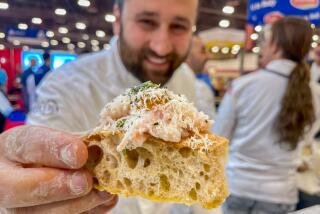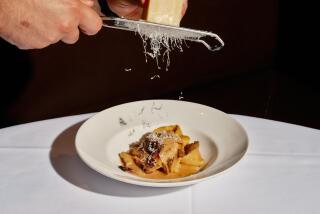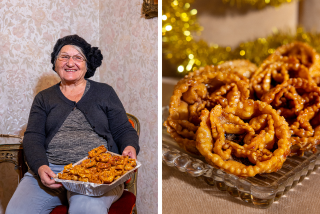Fresh and luscious
The first time I tasted fresh ricotta cheese, I was at lunch at an Italian restaurant in New York. I’d ordered dessert; my friend had requested a cheese course. Nevermind what I got, and nevermind that I don’t consider cheese dessert. All I could see was the snowy, white mound drizzled with a richly colored chestnut honey on his plate.
I reached across the table and took a bite. Made from sheep’s milk, the delicate curd was creamy and luxurious, yet tangy and complex -- altogether wonderful. In combination with the faintly sweet honey, it was so subtle, so intriguing and so delicious, I about fell out of my chair.
Ricotta, which literally means “re-cooked” in Italian, is a member of a family of cheeses known as whey cheeses. It uses the whey left over after the production of other cheeses, such as mozzarella or provolone, whereby, after the initial process of cooking the milk to separate the curd from the whey, the whey is cooked to form a second curd: ricotta cheese.
Ricotta can be made from cow, sheep, goat or buffalo milk. In Italy, the type of milk from which ricotta is made largely depends on the region -- but all over the country, ricotta is prized for its delicacy and freshness. It is bought the day it is made and eaten the day it’s purchased, unless it is being used in baking or as a filling. In the latter case, it may be set aside in a colander or the perforated basket in which it is most often sold to drain for two or three days, creating a drier cheese that holds up when baking dishes such as cassata, the classic Sicilian ricotta torte.
*
Shortlist of suppliers
Here, sheep’s milk ricotta, domestic or imported, is difficult, although not impossible, to find. A few domestic cheese makers produce sheep’s milk ricotta, but only for a short, springtime season. One to look for is Bellwether Farms’ excellent version. Very little of this ricotta, made in Sonoma County, makes it to Southern California, as the majority is delivered to Bay Area chefs who covet the seasonal delicacy. But occasionally the Cheese Store of Silverlake (at $9.99 a pound) and the Cheese Store of Beverly Hills (at $15 a pound) do carry it. And you don’t have to buy a full pound, but as little -- or as much -- as you need.
When you can find it, the more complex flavor of the sheep’s milk curd adds another dimension to any recipe calling for fresh ricotta. Anyone who hasn’t tasted cannoli or cassata in Sicily made with fresh sheep’s milk ricotta “at the seasonally favorable moment cannot know what cannoli or cassata really are,” says Victor Hazan, husband and collaborator of Italian food maven Marcella Hazan.
But when fresh, cow’s milk ricotta also becomes a prized ingredient. And unlike sheep’s milk ricotta, it is available year-round -- and it’s easy to find very fresh in Los Angeles because it’s made here. A local producer puts out a ricotta that rivals those made in Italy -- a delightful surprise to anyone who thinks of ricotta as the flavorless, rubbery, cottage cheese-like curd in the refrigerator section of grocery stores.
Used by L.A.’s most discerning chefs, the cow’s milk ricotta is made daily by Gioia in South El Monte. The company’s owner, Vito Girardi, is continuing a family tradition that extends back to his homeland, Puglia. Gioia began making the cheese 12 years ago and today delivers to many cheese shops and better restaurants locally.
Gioia’s fresh ricotta is rich, with a creamy texture, but it is also slightly dry, from its whey having been drained as is traditional in Italy. Its taste is mild, with slightly buttery nuances. At $4.49 a pound at Bay Cities Italian Deli & Bakery in Santa Monica (or $5.99 a pound at the Cheese Store of Beverly Hills), this is a bargain.
For most American cooks, ricotta means one thing: lasagna. But ask an Italian what to do with ricotta, and he or she is likely to look at you as if you’ve asked what to do with butter. Eat it on bread. Sprinkle it with salt. Sprinkle it with sugar. Toss it with pasta. Mix it with sugar and pour espresso over it, for a sort of breakfast affogato. And that’s before you’ve even turned on the stove or oven.
In cooking, use ricotta to make gnocchi; lighter than potato gnocchi, they are like little clouds that absorb the flavor of the ragu they are classically tossed with. And of course ricotta fills tarts, cannoli and ravioli. A classic Sardinian dessert is deep-fried ricotta-filled ravioli drizzled with lavender honey, a dish that, as far as I’m concerned, could be the last word in desserts.
*
Terrific any way
Ricotta’s virtues as a pasta filling are beyond question in a recipe by New York chef Mario Batali in his just-published “Molto Italiano” cookbook. The fresh ricotta (either sheep’s milk or cow’s milk) is mixed with aromatic ingredients (nutmeg, parsley and Parmesan), and the sauce enhanced with sage. The resulting ravioli are like light little pillows, a bite into one revealing a delightful pocket of the creamy curd.
A simpler way to enjoy fresh ricotta is the way Girardi and his wife, Monica, have it at home. Monica Girardi slices the cheese, dips it in egg, dredges it in flour, and fries it in olive oil -- a method she learned from her mother-in-law. The quick cooking slightly warms and softens the ricotta. The olive oil enhances the flavor. The fried cheese is lovely sprinkled with coarse sea salt, served on a bed of lemon and olive oil-dressed arugula or with sliced, ripe tomatoes.
In fact, the mild flavor of ricotta lends itself to all kinds of experimentation. Salvatore Marino, chef-owner of Il Grano in West Los Angeles, purees the creamy curd with sofritto (a mixture of sauteed vegetables that are the foundation of many Italian dishes) and vegetable stock to make a rich soup served either on its own or topped with a small piece of sauteed red mullet, black truffles or fresh burrata cheese. He got the idea from ricotta di fruscella, the skin skimmed off a batch of ricotta just after it coagulates, which Marino knew his grandfather to enjoy on a piece of bread, sprinkled with sugar.
As lovely as Marino’s soup is, when I find myself with a tub of fresh ricotta, it rarely makes it into such deliberate preparations. I mix it with milk and sugar into a sweet soup that I might top with fresh strawberries.
But most likely, I’ll spoon it into a bowl, drizzle it with chestnut honey, sit down, dip in and swoon.
*
Warm ricotta soup
Total time: 30 minutes
Servings: 8 as an appetizer
Note: From Salvatore Marino at Il Grano Restaurant. Fresh ricotta and burrata cheeses are available at Bay Cities Italian Deli & Bakery in Santa Monica, Beverly Hills Cheese Store in Beverly Hills and Tutto Latte Express in Hollywood. The Cheese Shop of Silverlake also carries fresh ricotta. Bristol Farms Pasadena, Gelson’s Pasadena and Whole Foods Brentwood also carry burrata.
1/2 cup best quality extra virgin olive oil, peppery, fruity, but not too green
1 tablespoon grated carrot
1 tablespoon grated celery
1 teaspoon grated shallot
Salt, pepper
1 cup fresh ricotta
1 cup vegetable stock
3 tablespoons burrata cheese
1. Heat the olive oil in a small skillet over medium-high heat. Add the grated carrot, celery and shallot, season with salt and pepper, and saute for about 4 minutes, stirring often to prevent browning, until they are very tender.
2. Add the ricotta and mash it with a wooden spoon or sturdy spatula to mix it with the vegetables and oil. Cook for about 30 seconds just to integrate.
3. Add the vegetable stock. Bring to a boil, reduce the heat and simmer for 3 to 5 minutes. Allow to cool slightly before pouring into the jar of a blender. Puree until smooth.
4. To serve, pour the soup into 8 warmed espresso cups. Place the burrata in a stainless steel dish and heat in a 350 oven for about 1 minute (or about the time it takes to pour the soup into the cups), just to take the chill off. Remove the burrata from the oven, place about 1 teaspoon on each portion of soup, and serve.
Each serving: 189 calories; 4 grams protein; 1 gram carbohydrates; 0 fiber; 19 grams fat; 5 grams saturated fat; 20 mg. cholesterol; 28 mg. sodium.
--
Fried ricotta
Total time: 15
Servings: 4
Note: This recipe works best with a drier ricotta, one that has been drained of the whey, such as Gioia. From Monica Girardi, who owns Gioia with her husband Vito Girardi. She serves it on its own. I like it on a bed of lemon- and olive oil-dressed arugula, with a slice of fresh, salted tomato or alongside a steak.
1 cup fresh ricotta
1 large egg, lightly beaten
1/4 cup flour
Salt
1 cup extra virgin olive oil
1. Divide the ricotta into four equal portions and form into disks about one-half- to three-fourths-inch thick. Dip in the egg. Dredge in the flour, and sprinkle generously with salt.
2. Pour the olive oil into a small (8-inch) skillet and heat over medium-high heat until a pinch of flour sizzles when dropped in the pan. Slide the ricotta disks into the oil and fry until golden brown, about 1 minute. Carefully turn and cook the other side until golden, about 1 more minute. Remove and place on a paper towel to drain for a few moments. Serve warm.
Each serving: 274 calories; 9 grams protein; 8 grams carbohydrates; 0 fiber; 23 grams fat; 7 grams saturated fat; 85 mg. cholesterol; 70 mg. sodium.
--
Tortelloni with sage butter
Total time: 1 hour, 15 minutes, plus 30 minutes for resting dough
Servings: 6
Note: From “Molto Italiano: 327 Simple Italian Recipes to Cook at Home” by Mario Batali. Gioia fresh cow’s milk ricotta is available at Bay Cities Italian Deli & Bakery in Santa Monica. Bellwether Farms’ fresh sheep’s milk ricotta is available at the Cheese Store of Silverlake and the Cheese Store of Beverly Hills.
Basic pasta dough
3 1/2 cups all-purpose flour, plus a little extra for kneading
5 large eggs
1. Mound the flour in the center of a large wooden board. Make a well in the center of the flour and add the eggs. Using a fork, beat the eggs and then incorporate the flour, starting with the inner rim of the well. As you expand the well, keep pushing the flour up to retain the well shape (do not worry if it looks messy). When half of the flour is incorporated, the dough will begin to come together.
2. Start kneading the dough, using primarily the palms of your hands. Once the dough is a cohesive mass, set the dough aside and scrape up and discard any dried bits of dough.
3. Lightly flour the board and continue kneading for 10 minutes, dusting the board with additional flour as necessary. The dough should be elastic and may be a little sticky. Wrap the dough in plastic wrap and allow to rest for 30 minutes at room temperature before using.
Tortelloni with sage butter
1 1/4 pounds pasta dough
8 ounces fresh sheep’s milk or cow’s milk ricotta
1 1/2 cups freshly grated Parmigiano-Reggiano, divided
2 large eggs, lightly beaten
1/2 teaspoon freshly grated nutmeg
1/4 cup finely chopped Italian parsley
2 tablespoons plus 1/4 teaspoon salt, divided
1/8 teaspoon ground pepper
1/4 cup ( 1/2 stick) unsalted butter
8 fresh sage leaves
1. Divide the pasta dough into 4 pieces. Roll each out on a pasta machine through to the thinnest setting possible without tearing the pasta. Lay the sheets on a floured surface; cover with plastic wrap.
2. In a large bowl, combine the ricotta, 1 cup Parmigiano-Reggiano, the eggs, nutmeg and parsley, and mix until thoroughly blended. Season with one-fourth teaspoon salt and the pepper. Set aside.
3. To make the tortelloni, cut the pasta sheets into 3-inch squares, cutting only 4 or so at a time so that the pasta doesn’t dry out while you are assembling the tortelloni. Place a generous teaspoon of the filling in the center of each square, fold the dough over to form a triangle, and press the edges together to seal. Then bring the two bottom points together, overlapping them slightly, and pinch together to seal. Transfer the tortelloni to a baking sheet lined with a kitchen towel.
4. Bring 6 quarts of water to a boil in a large pot, and add the remaining 2 tablespoons of salt. Meanwhile, in a 12-inch saute pan, melt the butter with the sage leaves. Set aside.
5. Drop the pasta into the boiling water. Cook at a brisk simmer until tender, 3 to 4 minutes.
6. Turn off the heat and, using a slotted spoon or spider, remove the tortelloni from the water, draining well, and place in the pan with the butter and sage. Toss to coat, then add the remaining one-half cup of Parmigiano and toss gently over medium heat until the pasta is well coated and cheese has slightly melted. Transfer to a warmed serving bowl and serve immediately.
Each serving: 573 calories; 27 grams protein; 58 grams carbohydrates; 2 grams fiber; 25 grams fat; 13 grams saturated fat; 304 mg. cholesterol; 520 mg. sodium.


